Welcome to our article on the 23 Common Birds in Oregon!
If you’re a bird enthusiast or just curious about the birds that call this beautiful state home, you’ve come to the right place.
In this article, we’ll introduce you to some of the most frequently sighted birds in Oregon, providing you with interesting facts about their appearance, behavior, and habitat.
So, whether you’re planning a birdwatching trip or simply want to learn more about the avian wildlife in your area, read on to discover some of the amazing birds you can find in Oregon.
| Image | Bird | Features | Price |
|---|---|---|---|
 |
| 9.7 | Check Price |
 |
| 9.5 | Check Price |
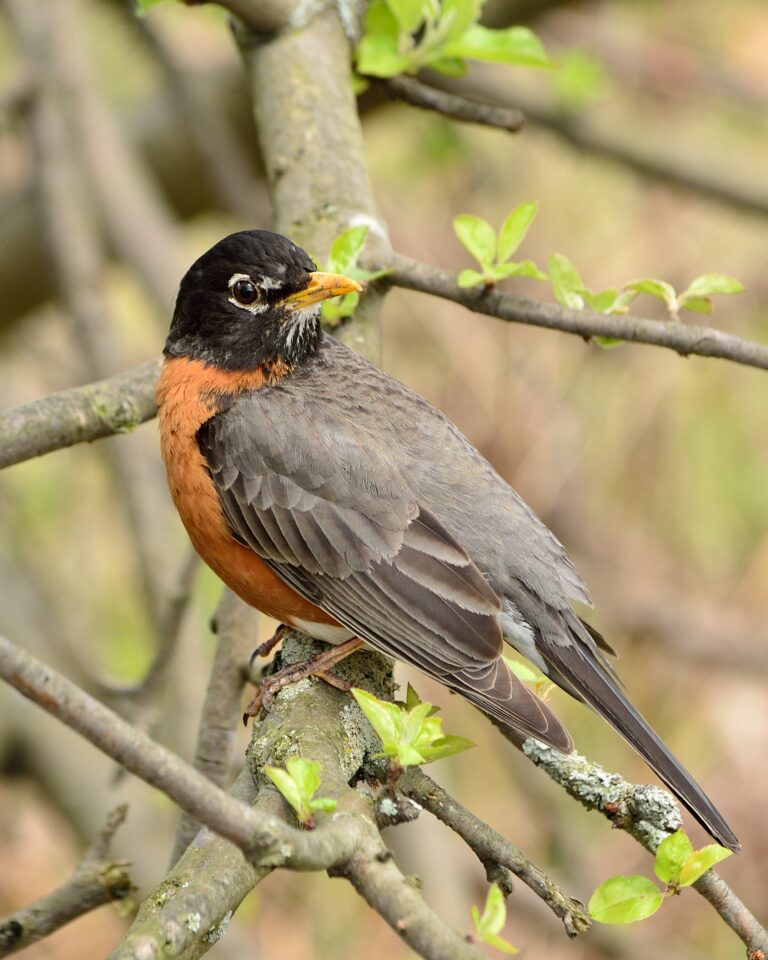 |
| 9.1 | Check Price |
 |
| 8.8 | Check Price |
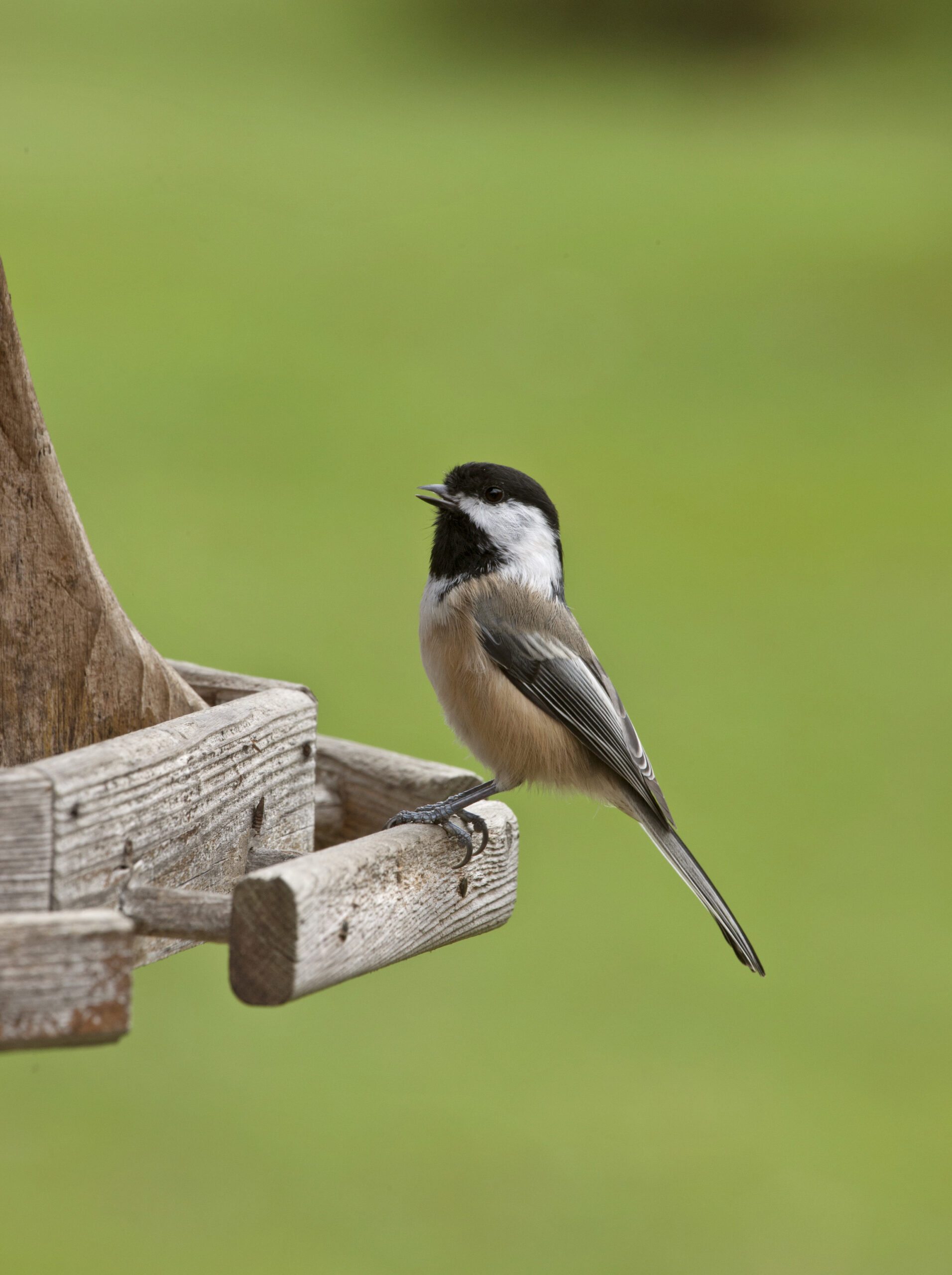 |
| 8.6 | Check Price |
 |
| 8.2 | Check Price |
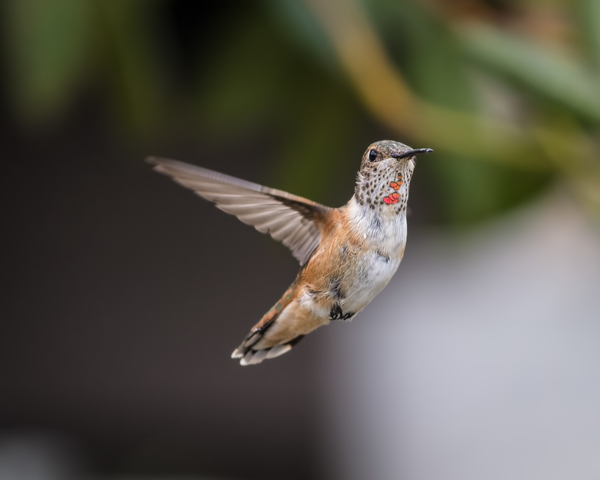 |
| 8 | Check Price |
 |
| 7.7 | Check Price |
 |
| 7.4 | Check Price |
 |
| 7.2 | Check Price |
 |
| 9.5 | Check Price |
 |
| 9.5 | Check Price |
 |
| 9.5 | Check Price |
 |
| 9.5 | Check Price |
 |
| 9.5 | Check Price |
 |
| 9.5 | Check Price |
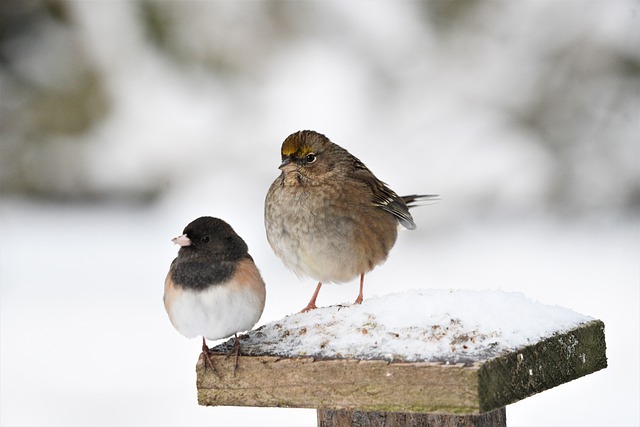 |
| 9.5 | Check Price |
 |
| 9.5 | Check Price |
 |
| 9.5 | Check Price |
 |
| 9.5 | Check Price |
 |
| 9.5 | Check Price |
 |
| 9.5 | Check Price |
 |
| 9.5 | Check Price |
Common Birds in Oregon
1. Song Sparrow

The Song Sparrow (Melospiza melodia) is a medium-sized sparrow commonly found in North America.
Song Sparrows have a streaked brown upper body and a white or gray underbody with dark streaks.
They have a rounded head, a long tail, and a robust, conical bill.
Their most distinctive feature is a dark spot in the center of their breast, known as a “central breast spot” or “stickpin.”
Adult males and females have similar plumage, making them difficult to tell apart.
Song Sparrows measure about 4.7 to 6.7 inches (12 to 17 cm) in length from the tip of their bill to the end of their tail.
These birds typically weigh between 0.4 to 1.9 ounces (12 to 53 grams), with an average weight of around 0.8 ounces (22 grams).
Song Sparrows have a wingspan ranging from 7.1 to 9.4 inches (18 to 24 cm).
Song sparrows aren’t as noticeable as other backyard birds, but in the spring and summer, these mostly brown-streaked birds utilize their almost continuous song to attract mates.
They’re typically perched on a low shrub singing in open, shrubby, and damp environments.
They’re frequently seen at backyard feeders.
Beetles, caterpillars, midges, spiders, and earthworms are among the insects and plants that Song Sparrows consume.
They’ll eat sunflower seeds, wild cherries, wheat, and rice, among other things.
Use black oil pumpkin seeds and nyjer on stage feeders to bring more song sparrows to your yard feeders.
Below are the characteristics of the Song Sparrow,
| Scientific Name | Melospiza melodia |
| Family Name | Passerellidae |
| Length | 11-18 cm (4.3-7.1 inches) |
| Weight | 12-53 grams (0.4-1.9 ounces) |
| Wingspan | 18-25 cm (7.1-9.8 inches) |
| Habitat | Brushy areas, marshes, and fields |
| Food | Insects, seeds, and fruit |
2. American Crow

American Crow (Corvus brachyrhynchos) is a large and widespread species of crow native to North America.
American Crows are large, all-black birds with a strong build, a stout bill, and long legs.
They have an iridescent sheen on their feathers, which can appear purple or blue in certain lighting conditions.
Their eyes are dark brown, and they have a distinctive, loud, and harsh “caw” call.
They are often confused with the Common Raven, but American Crows are smaller and have a more rounded tail in flight.
American Crows range from 16 to 21 inches (40 to 53 cm) in length, from the tip of their bill to the end of their tail.
These birds typically weigh between 11 to 21 ounces (315 to 600 grams), with an average weight of around 16 ounces (450 grams).
American Crows have a wingspan ranging from 33 to 39 inches (84 to 100 cm).
They may be found in a variety of environments, including trees, woodlands, fields, beaches, and cities.
They consume a wide variety of foods and like to graze on the ground, where they eat earthworms, insects, seeds, and fruit.
They also consume fish, young turtles, mussels, and clams, as well as eggs and nestlings from a variety of bird species.
Huge groups of approximately two million American Crows assemble in communal roosts throughout the winter.
If you sprinkle peanuts in your backyard, you can attract more American Crows, but if you leave rubbish or pet food out, they can become a problem.
Below are the characteristics of the American Crow,
| Scientific Name | Corvus brachyrhynchos |
| Family Name | Corvidae |
| Length | 40-53 cm (15.7-20.9 inches) |
| Weight | 316-620 grams (11.1-21.9 ounces) |
| Wingspan | 85-100 cm (33.5-39.4 inches) |
| Habitat | Woodlands, fields, cities, and suburbs |
| Food | Insects, seeds, fruit, carrion, and small vertebrates |
3. American Robin

The American Robin (Turdus migratorius) is a familiar and widespread bird species native to North America.
American Robins are medium-sized birds with distinct orange breasts, a gray-brown back, and a dark head.
They have a white eye-ring, a yellow bill, and dark gray or black legs.
The males tend to have darker, more vibrant colors than the females.
Juvenile American Robins have spotted breasts, which distinguishes them from adults.
American Robins range from 9 to 11 inches (23 to 28 cm) in length, from the tip of their bill to the end of their tail.
These birds typically weigh between 2.7 to 3.0 ounces (77 to 85 grams), with an average weight of around 2.8 ounces (80 grams).
American Robins have a wingspan ranging from 12 to 16 inches (31 to 40 cm).
American Robins may be found in a variety of environments, including woods, forests, and mountains, as well as fields, parks, and lawns.
American Robins are omnivorous, with a diet consisting mainly of invertebrates, such as earthworms, insects, and spiders, as well as fruits and berries.
Below are the characteristics of the American Robin,
| Scientific Name | Turdus migratorius |
| Family Name | Turdidae |
| Length | 9-11 inches (23-28 cm) |
| Weight | 2.7-3 oz (77-85 grams) |
| Wingspan | 12-16 inches (31-40 cm) |
| Habitat | Forests, parks, gardens, lawns, fields |
| Food | Insects, fruits, berries, earthworms |
4. Spotted Towhee

The Spotted Towhee (Pipilo maculatus) is a medium-sized bird belonging to the New World sparrow family, native to the western parts of North America.
Spotted Towhees are striking birds with black heads, upper bodies, and tails.
They have bright rufous flanks and conspicuous white spots on their wings and back.
Their bellies are white, and their eyes are red.
The females have a similar pattern but are generally more muted in color, with a brownish head and upper body instead of black.
Both sexes have long tails and thick, conical bills.
Spotted Towhees range from 7 to 8.5 inches (18 to 21.5 cm) in length, from the tip of their bill to the end of their tail.
These birds typically weigh between 1.1 to 1.9 ounces (32 to 54 grams), with an average weight of around 1.4 ounces (40 grams).
Spotted Towhees have a wingspan ranging from 11 to 12 inches (28 to 30 cm).
They are approximately the size of a Robin and have lengthy tails.
Spotted Towhees are omnivorous and have a varied diet consisting of insects, arachnids, seeds, fruits, and occasionally small vertebrates.
Insects such as beetles, caterpillars, and ants make up a significant portion of their diet, especially during the breeding season.
In the non-breeding season, they consume more seeds and fruits from various plants, such as grasses, poison oak, and elderberries.
They are native to the Pacific coast, but after mating, they migrate to the northern central states and emerge in a swath from north to south throughout the whole central states in the winter.
If you allow overgrown borders in your yard more Spotted Towhees will flock to a platform or ground feeders for Black Oil Sunflower seeds and Milo.
Below are the characteristics of the Spotted Towhee,
| Scientific Name | Pipilo maculatus |
| Family Name | Passerellidae |
| Length | 7.1-8.7 inches (18-22 cm) |
| Weight | 1.2-1.8 oz (33-50 grams) |
| Wingspan | 10.6-12.2 inches (27-31 cm) |
| Habitat | Forest edges, shrubby areas, chaparral |
| Food | Insects, seeds, fruits, small invertebrates |
5. Black-capped Chickadee

The Black-capped Chickadee (Poecile atricapillus) has a small body and a round head.
Black-capped Chickadees have a distinctive black cap and bib, white cheeks, and a gray back.
Their underparts are pale gray with a slight buffy color on the flanks.
They have short, rounded wings and a relatively long tail.
The bill is short and straight, while the legs and feet are dark gray.
Both males and females have similar plumage, making it difficult to tell them apart visually.
Black-capped Chickadees range from 4.7 to 5.9 inches (12 to 15 cm) in length, from the tip of their bill to the end of their tail.
These birds typically weigh between 0.3 to 0.4 ounces (8 to 12 grams), with an average weight of around 0.4 ounces (10 grams).
Black-capped Chickadees have a wingspan ranging from 6.3 to 8.3 inches (16 to 21 cm).
These birds will cheerfully eat from your garden feeders and examine everything, including you!
They have black beaks and capes, white cheeks, and grey backs, wings, and tails.
Forests, open woodlands, and parks are all good places to look for them.
Black-capped Chickadees are omnivorous and have a varied diet consisting primarily of insects, arachnids, seeds, and berries.
They forage on insects and their larvae, including caterpillars, beetles, and spiders, by searching for them on tree bark, branches, and leaves.
To bring more Black-capped Chickadees to your garden try seeds and nut butter.
They’ll even eat from your hand, and they’re usually the first to explore new feeders.
They’ll utilize nest boxes as well, especially if they’re filled with wood shavings.
Below are the characteristics of the Black-capped Chickadee,
| Scientific Name | Poecile atricapillus |
| Family Name | Paridae |
| Length | 4.7-5.9 inches (12-15 cm) |
| Weight | 0.32-0.49 oz (9-14 grams) |
| Wingspan | 6.3-8.3 inches (16-21 cm) |
| Habitat | Mixed and deciduous forests, gardens, swamps |
| Food | Insects, seeds, berries, small invertebrates |
6. European Starling

The European Starling (Sturnus vulgaris), also known as the Common Starling, is a medium-sized bird native to Eurasia.
It was introduced to North America in the late 19th century and has since become widespread across the continent
Despite the fact that European starlings are not native to North America, they have become one of the most frequent songbirds.
European Starlings are stocky birds with short tails, pointed wings, and a long, slender, pointed bill.
They have iridescent black plumage with a purple or green sheen, which is covered in white speckles during the fall and winter months.
The speckles fade in the spring and summer, revealing a glossy black plumage.
The bill is dark during the breeding season and turns yellow in the non-breeding season.
Males and females have similar plumage, although males tend to have larger throat feathers and a blue-gray base to their bills.
European Starlings can be found in a wide variety of habitats, including open woodlands, grasslands, agricultural fields, and urban areas.
These birds which some consider pests owing to their aggressive nature, fly in big, loud flocks and may be observed sitting in groups on the tops of trees or soaring over fields in flocks.
European Starlings are omnivorous and have a varied diet consisting of insects, earthworms, berries, fruits, seeds, and occasionally small vertebrates.
They primarily feed on invertebrates, such as beetles, flies, caterpillars, and spiders, which they forage from the ground or by probing into soil and grass with their bills.
They also consume a variety of fruits and berries from plants, such as cherries, grapes, and juniper berries.
To attract more European Starlings to your yard feeder, try using suet, cracked corn, or peanuts.
Below are the characteristics of the European Starling,
| Scientific Name | Sturnus vulgaris |
| Family Name | Sturnidae |
| Length | 7.9-9.1 inches (20-23 cm) |
| Weight | 2.1-3.4 oz (60-96 grams) |
| Wingspan | 12-17 inches (31-43 cm) |
| Habitat | Urban areas, farmlands, grasslands, forests |
| Food | Insects, seeds, fruits, small vertebrates |
7. Anna’s Hummingbird

Anna’s Hummingbird (Calypte anna) is a medium-sized hummingbird native to the western coast of North America.
Anna’s Hummingbirds have plump bodies, short tails, and iridescent green backs.
Males have a distinctive rose-red gorget (throat patch) and a red crown, while females have a green crown and a white throat with some iridescent red spotting.
Both sexes have grayish-white underparts and a relatively straight, slender bill.
Juvenile Anna’s Hummingbirds resemble females but may have more diffuse spotting on their throats.
Anna’s Hummingbirds range from 3.5 to 4.3 inches (9 to 11 cm) in length, from the tip of their bill to the end of their tail.
These birds typically weigh between 0.1 to 0.2 ounces (3 to 6 grams), with an average weight of around 0.14 ounces (4 grams).
Anna’s Hummingbirds have a wingspan ranging from 4.7 to 5.1 inches (12 to 13 cm).
Anna’s Hummingbirds are the most frequent hummingbird throughout the Pacific Coast, despite the fact that they do not migrate.
During courting, the males ascend up to 130 feet in the air before plunging back to the earth with a blast of noise from their tail feathers.
Anna’s Hummingbirds primarily feed on nectar from flowering plants, which provides them with the high-energy sugars they need to power their rapid flight.
They also consume insects and spiders, which provide essential protein and other nutrients.
During the spring, they may be seen near huge colorful flowers and frequently visit hummingbird feeders, which you can fill with homemade hummingbird food and which they may visit throughout the year.
Below are the characteristics of Anna’s Hummingbird,
| Scientific Name | Calypte anna |
| Family Name | Trochilidae |
| Length | 3.9-4.3 inches (10-11 cm) |
| Weight | 0.1-0.2 oz (3-6 grams) |
| Wingspan | 4.7-5.5 inches (12-14 cm) |
| Habitat | Gardens, open woods, chaparral, coastal scrub |
| Food | Nectar, insects, spiders, tree sap |
8. Steller’s Jay

Steller’s Jay (Cyanocitta stelleri) is a striking, large songbird native to the western parts of North America. It is known for its bold appearance and inquisitive nature.
Steller’s Jays have a prominent black crested head, which contrasts with their vibrant blue body.
The black extends from the head to the upper back, and the rest of the body, wings, and tail are a deep blue, often with white or gray streaks or barring.
Their eyes are dark, and they have a strong, black bill.
Steller’s Jays are relatively large birds, with a body length ranging from 11 to 12 inches (28 to 30 centimeters).
The weight of an adult Steller’s Jay typically varies between 3.5 to 4.9 ounces (100 to 140 grams).
Steller’s Jays have a wingspan of approximately 17 to 18 inches (43 to 46 centimeters).
They can be found in the mountains’ evergreen woods, as well as at picnic tables, campsites, and home feeders. They build their nests out of the mud.
These jays are omnivorous, which means they eat a wide variety of food items.
Their diet primarily consists of seeds, nuts (especially acorns and pine nuts), fruits, and insects.
Below are the characteristics of the Steller’s Jay,
| Scientific Name | Cyanocitta stelleri |
| Family Name | Corvidae |
| Length | 11.8-13.4 inches (30-34 cm) |
| Weight | 3.5-4.9 oz (100-140 grams) |
| Wingspan | 17.1-17.7 inches (43-45 cm) |
| Habitat | Coniferous forests, mixed woodlands, mountainous areas |
| Food | Nuts, seeds, fruits, insects, eggs, small vertebrates |
9. Ruby-crowned Kinglet

Ruby-crowned Kinglet (Regulus calendula) is a small, energetic songbird commonly found across North America.
They are known for their quick movements, vibrant crown, and distinctive songs.
Ruby-crowned Kinglets are olive-green birds with a pale yellowish breast and a bold white eye-ring.
Males have a hidden ruby-red crown patch, which they reveal when excited or agitated.
These birds also have two white wing bars and a short, thin bill.
Ruby-crowned Kinglets are small birds, with a body length ranging from 3.5 to 4.3 inches (9 to 11 centimeters).
The weight of an adult Ruby-crowned Kinglet is typically between 0.2 to 0.3 ounces (5 to 10 grams).
Ruby-crowned Kinglets have a wingspan of approximately 6.3 to 7.1 inches (16 to 18 centimeters).
Before winter in the southern and southwestern states of the United States and Mexico, they breed in Canada and the western Rockies.
They’re also visible during migration when they’re in large numbers.
Ruby-crowned Kinglets are fast-moving, silent birds that flutter among the foliage of lower branches, bushes, and trees in search of spiders and insects.
These birds primarily feed on insects and other small invertebrates like spiders, which they glean from the foliage of trees and shrubs.
They also consume some seeds and fruits, especially during the winter months when insects are scarce.
Ruby-crowned Kinglets are known for their active foraging behavior, constantly flitting from branch to branch in search of food.
Below are the characteristics of the Ruby-crowned Kinglet,
| Scientific Name | Regulus calendula |
| Family Name | Regulidae |
| Length | 3.5-4.3 inches (9-11 cm) |
| Weight | 0.2-0.3 oz (5-10 grams) |
| Wingspan | 6.3-7.1 inches (16-18 cm) |
| Habitat | Coniferous and mixed forests, shrubby areas, gardens |
| Food | Insects, spiders, some seeds and fruits |
10. Western Meadowlark

Western Meadowlarks may brighten your day with their brilliant yellow bellies and melodic singing.
Western Meadowlark (Sturnella neglecta) is a medium-sized songbird native to the grasslands and meadows of western and central North America.
It is known for its vibrant colors, distinctive markings, and melodic song.
Western Meadowlarks have a bright yellow chest and belly, with a bold black “V” or chevron-shaped patch on their breast.
Their upper parts are brown with black streaks, and they have a white flanking stripe that is visible in flight.
The head features a white eyebrow stripe and a white malar stripe (cheek stripe) that contrasts with the dark mask.
They have a long, sharp, pointed bill that is well-suited for foraging in grassy habitats.
Western Meadowlarks are medium-sized birds, with a body length ranging from 8.3 to 10.2 inches (21 to 26 centimeters).
The weight of an adult Western Meadowlark is typically between 3.1 to 4.1 ounces (90 to 115 grams).
Western Meadowlarks have a wingspan of approximately 14 to 16 inches (36 to 40 centimeters).
This is most likely why they are so popular, to the point that they are the official bird of six states.
These birds breed in the northern United States and Canada before migrating to the southern United States.
Western Meadowlarks can be found foraging on insects and seeds from weeds and seeds in grassy meadows, either alone or in small groups.
These birds are primarily insectivores, feeding on insects such as grasshoppers, crickets, beetles, and ants.
They also consume seeds and grains, especially during the non-breeding season when insects are less available.
Below are the characteristics of the Western Meadowlark,
| Scientific Name | Sturnella neglecta |
| Family Name | Icteridae |
| Length | 8.3-10.2 inches (21-26 cm) |
| Weight | 3.1-4.1 oz (89-116 grams) |
| Wingspan | 14.6-16.1 inches (37-41 cm) |
| Habitat | Grasslands, meadows, fields, prairies |
| Food | Insects, seeds, grains, some fruits |
11. White-crowned Sparrow

White-crowned Sparrow (Zonotrichia leucophrys) is a medium-sized songbird widely distributed across North America.
It is known for its striking head pattern, pleasant song, and adaptable nature.
White-crowned Sparrows have a distinctive head pattern that features bold black and white stripes.
The crown has alternating black and white stripes, with a white central stripe flanked by black stripes on either side.
Their face has a gray cheek patch and a black eye line that contrasts with the white eyebrow stripe.
The back is brown with black streaks, while the breast and belly are pale gray.
White-crowned Sparrows have a relatively long tail and a conical-shaped bill.
White-crowned Sparrows have a body length ranging from 5.9 to 6.7 inches (15 to 17 centimeters).
The weight of an adult White-crowned Sparrow typically varies between 0.9 to 1.1 ounces (25 to 31 grams).
White-crowned Sparrows have a wingspan of approximately 9.1 to 9.8 inches (23 to 25 centimeters).
They reproduce in Alaska and northern Canada before traveling to the lower states and Mexico for the wintertime.
Some may stay throughout the entire year near the Pacific Coast and west.
These birds primarily feed on seeds and insects.
Seeds, grains, and fruits make up the majority of their diet during the non-breeding season, while insects and other invertebrates are consumed more frequently during the breeding season.
Below are the characteristics of the White-crowned Sparrow,
| Scientific Name | Zonotrichia leucophrys |
| Family Name | Passerellidae |
| Length | 5.9-6.7 inches (15-17 cm) |
| Weight | 0.88-1.16 oz (25-33 grams) |
| Wingspan | 8.3-9.8 inches (21-25 cm) |
| Habitat | Scrublands, fields, forest edges, gardens |
| Food | Seeds, insects, fruits, small invertebrates |
12. Downy Woodpecker

Downy Woodpecker (Picoides pubescens) is a small, widespread woodpecker native to North America.
It is known for its distinctive black-and-white markings, agile movements, and ability to thrive in various habitats, including forests, woodlands, and urban areas.
Downy Woodpeckers have primarily black and white plumage.
Their back is black with white bars, while the underparts are white.
They have a white patch on the lower back and outer tail feathers with black bars.
The head features a white stripe above the eye and a black stripe below it, which extends to the nape.
Males have a small red patch on the back of their heads, while females lack this feature.
Downy Woodpeckers have short, stout bills, which distinguishes them from similar-looking Hairy Woodpeckers.
They’re commonly confused for chickadees and nuthatches, among other species.
They have a red patch on the back of their skulls and are monochrome in appearance.
They resemble Hairy Woodpeckers but are smaller.
Downy Woodpeckers have a body length ranging from 5.5 to 6.7 inches (14 to 17 centimeters).
The weight of an adult Downy Woodpecker typically varies between 0.7 to 1 ounce (21 to 28 grams).
Downy Woodpeckers have a wingspan of approximately 9.8 to 11.8 inches (25 to 30 centimeters).
Downy woodpeckers may be found in woodlots, along streams, municipal parks, and backyards and they consume berries, acorns, and grains in addition to insects and beetle larvae.
Below are the characteristics of the Downy Woodpecker,
| Scientific Name | Picoides pubescens |
| Family Name | Picidae |
| Length | 5.5-6.7 inches (14-17 cm) |
| Weight | 0.71-1.16 oz (20-33 grams) |
| Wingspan | 9.8-11.8 inches (25-30 cm) |
| Habitat | Deciduous forests, woodlands, parks, gardens |
| Food | Insects, seeds, berries, tree sap, small invertebrates |
13. Lesser Goldfinch
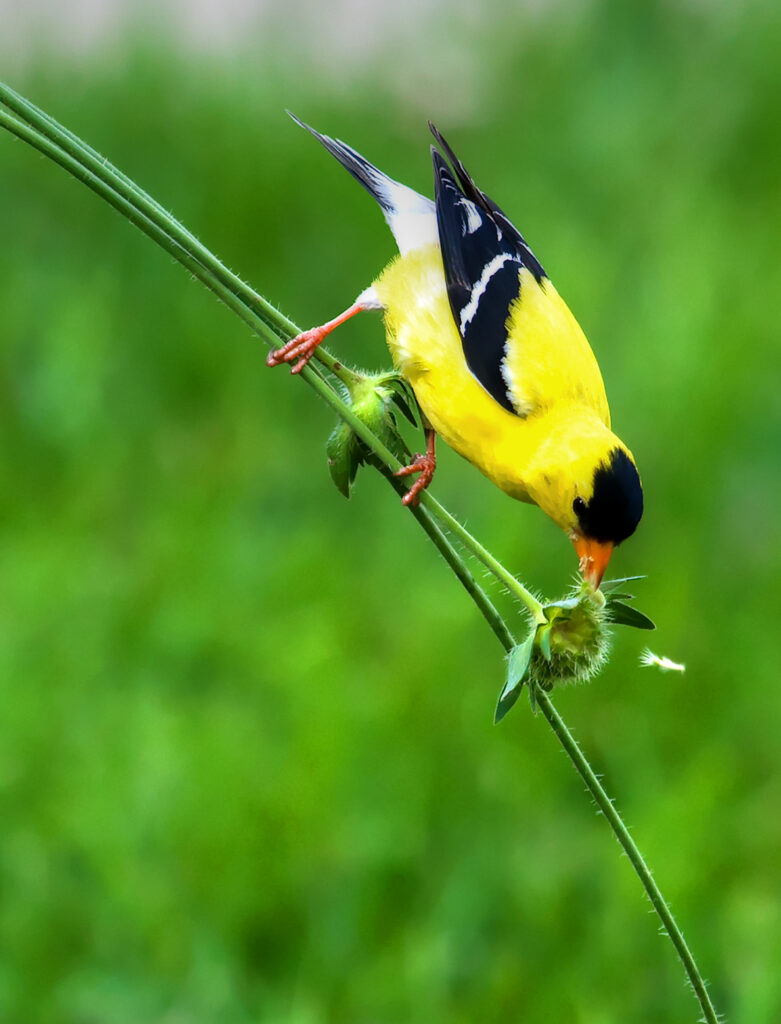
Lesser Goldfinch (Spinus psaltria) is a small, colorful songbird native to the southwestern United States, Mexico, and Central America.
It is known for its vibrant plumage, sweet songs, and lively social behavior.
Lesser Goldfinches display sexual dimorphism, meaning that males and females have different appearances.
Males have a bright yellow chest and belly, a black cap on their head, and black wings with white wing bars.
The back is either black or olive-green, depending on the subspecies.
Females are more subdued in color, with an overall olive-gray upper body and dull yellow underparts.
Both sexes have a short, conical bill and a notched tail.
Lesser Goldfinches have a body length ranging from 3.5 to 4.7 inches (9 to 12 centimeters).
The weight of an adult Lesser Goldfinch typically varies between 0.3 to 0.4 ounces (8 to 11 grams).
Lesser Goldfinches have a wingspan of approximately 6.3 to 7.5 inches (16 to 19 centimeters).
They are Residents in the extreme southwest, with those in their area to the north breeding and moving south.
Large flocks of Lesser Goldfinches can be found in open environments such as thickets, weedy fields, woodland clearings, and gardens.
These birds primarily feed on seeds, especially those from plants in the sunflower family.
They also consume small insects, berries, and fruits.
Below are the characteristics of the Lesser Goldfinch,
| Scientific Name | Spinus psaltria |
| Family Name | Fringillidae |
| Length | 3.5-4.7 inches (9-12 cm) |
| Weight | 0.28-0.39 oz (8-11 grams) |
| Wingspan | 5.9-7.5 inches (15-19 cm) |
| Habitat | Woodlands, gardens, shrubby areas, riparian zones |
| Food | Seeds, fruits, insects, small invertebrates |
14. Cedar Waxwing

Cedar Waxwing (Bombycilla cedrorum) is a medium-sized, elegant songbird native to North America.
It is known for its silky plumage, unique markings, and gregarious social behavior.
Cedar Waxwings have a sleek, crested head, and their overall plumage is a blend of pale brown, gray, and yellow.
They have a black mask edged in white around their eyes, a yellow-tipped tail, and a thin, black bill.
The wings feature a row of red, waxy-looking tips on the secondary feathers, which give the bird its name. Both males and females have similar appearances.
Cedar Waxwings have a body length ranging from 5.5 to 6.7 inches (14 to 17 centimeters).
The weight of an adult Cedar Waxwing typically varies between 1 to 1.4 ounces (30 to 40 grams).
Cedar Waxwings have a wingspan of approximately 8.7 to 11.8 inches (22 to 30 centimeters).
They pass most of the year in the northern and the winters in the southern areas.
They may be found in berry bushes, woods, and streams, and have a high-pitched cry.
These birds primarily feed on fruits and berries, such as juniper, dogwood, and cedar.
They also consume insects, especially during the breeding season when they require more protein.
Below are the characteristics of the Cedar Waxwing,
| Scientific Name | Bombycilla cedrorum |
| Family Name | Bombycillidae |
| Length | 5.5-6.7 inches (14-17 cm) |
| Weight | 1.1-1.3 oz (30-37 grams) |
| Wingspan | 8.7-11.8 inches (22-30 cm) |
| Habitat | Woodlands, gardens, orchards, riparian zones |
| Food | Berries, fruits, insects, flower petals |
15. Swainson’s Thrush

Swainson’s Thrush (Catharus ustulatus) is a medium-sized songbird native to North and South America.
It is known for its melodic song, secretive nature, and distinctive appearance.
Swainson’s Thrushes have a brownish-olive upper body and a pale, buffy-white underbelly with faint spotting on the chest.
The face features a pale eye-ring and a buffy stripe above the eye, giving them a distinctive “spectacled” appearance.
Their bill is relatively slender, and they have a round body shape with a short tail.
Swainson’s Thrushes spend the winter in Central and South America after breeding in Canada and Alaska.
Except for migration in the spring and fall, they are rarely seen in the lower 48.
Ground-level birdbaths and tree and shrub cover might help to attract more Swainson’s Thrushes to your yard.
These birds primarily feed on insects and other invertebrates, such as beetles, ants, and caterpillars.
They also consume fruits and berries, especially during migration and in their wintering grounds.
Below are the characteristics of the Swainson’s Thrush,
| Scientific Name | Catharus ustulatus |
| Family Name | Turdidae |
| Length | 6.3-7.9 inches (16-20 cm) |
| Weight | 0.95-1.41 oz (27-40 grams) |
| Wingspan | 11.8-12.6 inches (30-32 cm) |
| Habitat | Dense forests, woodlands, thickets |
| Food | Insects, berries, fruits, small invertebrates |
16. American Goldfinch
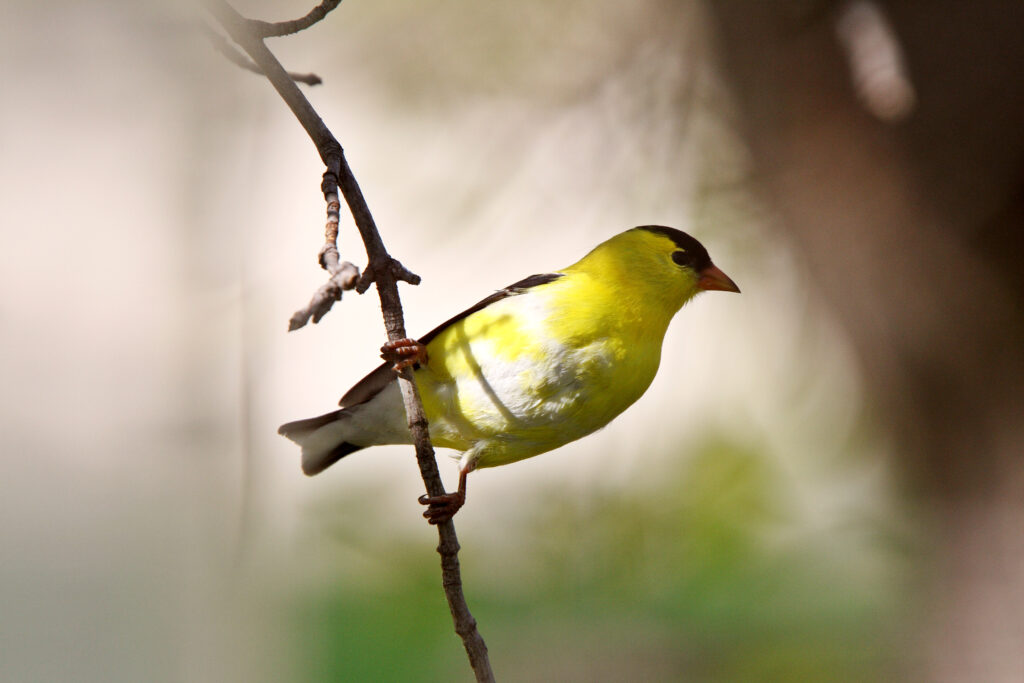
American Goldfinch (Spinus tristis) is a small, brightly colored songbird native to North America.
It is known for its vibrant plumage, sweet songs, and acrobatic feeding habits.
American Goldfinches display sexual dimorphism, with males and females having different appearances.
Breeding males have a bright yellow body, a black forehead, black wings with white wing bars, and a black tail with white markings.
Non-breeding males and females are more subdued in color, with an overall olive-brown body and pale yellow underparts.
Both sexes have a short, conical bill and a notched tail.
American Goldfinches have a body length ranging from 4.3 to 5.1 inches (11 to 13 centimeters).
The weight of an adult American Goldfinch typically varies between 0.4 to 0.7 ounces (11 to 20 grams).
American Goldfinches have a wingspan of approximately 7.5 to 8.7 inches (19 to 22 centimeters).
Before traveling to the southern states, American Goldfinches breed in the far northern states and Canada. In the remainder of the United States, they are present all year.
They forage for sunflower, thistle, and aster plants in weedy fields and overgrown places.
They’re also prevalent in parks, backyards, and suburbia.
To attract more American Goldfinches plant thistles and milkweed in your yard. They are attracted to most bird feeders and prefer sunflower and nyjer seed.
These birds primarily feed on seeds, especially those from plants in the sunflower family.
They also consume small insects and occasionally berries.
Below are the characteristics of the American Goldfinch,
| Scientific Name | Spinus tristis |
| Family Name | Fringillidae |
| Length | 4.3-5.1 inches (11-13 cm) |
| Weight | 0.39-0.71 oz (11-20 grams) |
| Wingspan | 7.5-8.7 inches (19-22 cm) |
| Habitat | Open habitats, meadows, fields, gardens |
| Food | Seeds, insects, small invertebrates |
17. Golden-Crowned Sparrow

Golden-crowned Sparrow (Zonotrichia atricapilla) is a medium-sized songbird native to the western parts of North America.
It is known for its distinctive head markings, melodic song, and adaptable nature.
Golden-crowned Sparrows have a brownish-gray upper body with streaks on their back and a pale grayish-brown breast and belly.
The head features a striking yellow crown bordered by black lateral stripes, which extend down the side of the head.
Both males and females have similar appearances.
The birds have a short, conical bill and a moderately long tail.
Golden-crowned Sparrows have a body length ranging from 5.5 to 6.3 inches (14 to 16 centimeters).
The weight of an adult Golden-crowned Sparrow typically varies between 0.9 to 1.2 ounces (26 to 35 grams).
Golden-crowned Sparrows have a wingspan of approximately 9.1 to 9.8 inches (23 to 25 centimeters).
Before traveling to the West Side for the wintertime, they spawn in Norway and far westward.
They may be seen scraping for seeds such as sumac and geranium in weedy fields in the winter, and they also consume fruit such as apples, grapes, and olives.
You may attract more Golden-crowned Sparrows to your yard by putting seeds in ground feeders or planting fruit-bearing native plants.
These birds primarily feed on seeds, insects, and plant material.
Seeds and grains make up a significant portion of their diet, particularly during the non-breeding season, while insects are more prevalent during the breeding season.
Below are the characteristics of the Golden-Crowned Sparrow,
| Scientific Name | Zonotrichia atricapilla |
| Family Name | Passerellidae |
| Length | 6.3-7.1 inches (16-18 cm) |
| Weight | 0.95-1.41 oz (27-40 grams) |
| Wingspan | 9.8-10.6 inches (25-27 cm) |
| Habitat | Open habitats, brushy areas, forest edges, tundra |
| Food | Seeds, insects, fruits, small invertebrates |
18. California Scrub-Jay

California Scrub-Jay (Aphelocoma californica) is a medium-sized, boldly marked bird native to the western United States and Mexico.
It is known for its striking appearance, loud calls, and intelligent behavior.
California Scrub-Jays have a blue head, wings, and tail, contrasting with a gray-brown back and pale gray underparts.
The head features a distinct blue eyebrow stripe and a dark blue-to-black mask around the eyes and throat.
Both males and females have similar appearances.
California Scrub-Jays have a long tail and a stout, slightly hooked bill.
California Scrub-Jays have a body length ranging from 11.4 to 12.2 inches (29 to 31 centimeters).
The weight of an adult California Scrub-Jay typically varies between 2.5 to 3.5 ounces (70 to 100 grams).
California Scrub-Jays have a wingspan of approximately 15 to 17 inches (38 to 43 centimeters).
They’re bigger than a robin but not as big as a crow.
They have a similar appearance to Wood house’s Scrub-Jay, but with more vibrant colors.
They can be found in brush, residential yards, and parks throughout the Pacific Coast.
These birds have an omnivorous diet, feeding on insects, seeds, fruits, small vertebrates, and bird eggs.
They are known for their caching behavior, where they store food items, such as acorns and seeds, in various locations to retrieve and consume later.
To lure more California Scrub-Jays to your yard, fill your feeders with sunflower seeds and peanuts.
Below are the characteristics of the California Scrub-Jay,
| Scientific Name | Aphelocoma californica |
| Family Name | Corvidae |
| Length | 11.4-12.2 inches (29-31 cm) |
| Weight | 2.5-3.5 oz (70-100 grams) |
| Wingspan | 15.4-16.1 inches (39-41 cm) |
| Habitat | Scrublands, oak woodlands, chaparral |
| Food | Nuts, seeds, fruits, insects, eggs, small vertebrates |
19. Red-winged Blackbird
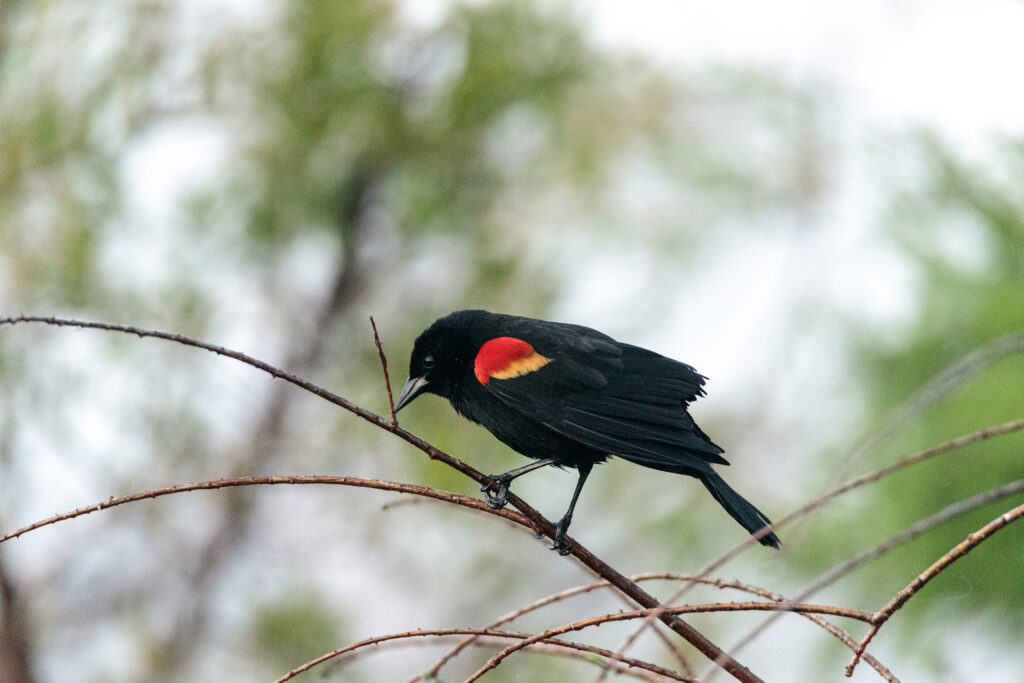
California Scrub-Jay (Aphelocoma californica) is a medium-sized, boldly marked bird native to the western United States and Mexico.
It is known for its striking appearance, loud calls, and intelligent behavior.
California Scrub-Jays have a blue head, wings, and tail, contrasting with a gray-brown back and pale gray underparts.
The head features a distinct blue eyebrow stripe and a dark blue-to-black mask around the eyes and throat.
Both males and females have similar appearances.
California Scrub-Jays have a long tail and a stout, slightly hooked bill.
California Scrub-Jays have a body length ranging from 11.4 to 12.2 inches (29 to 31 centimeters).
The weight of an adult California Scrub-Jay typically varies between 2.5 to 3.5 ounces (70 to 100 grams).
California Scrub-Jays have a wingspan of approximately 15 to 17 inches (38 to 43 centimeters).
They are frequently seen perched on telephone lines, and during the mating season, the males will fiercely protect their territory even attacking humans who come too close to their nests.
During the winter, they roost in huge flocks, numbering in the millions.
These birds have an omnivorous diet, feeding on insects, seeds, fruits, small vertebrates, and bird eggs.
Below are the characteristics of the Red-winged Blackbird,
| Scientific Name | Agelaius phoeniceus |
| Family Name | Icteridae |
| Length | 6.7-9.1 inches (17-23 cm) |
| Weight | 1.1-2.7 oz (32-77 grams) |
| Wingspan | 12.2-15.8 inches (31-40 cm) |
| Habitat | Marshes, wetlands, fields, meadows |
| Food | Seeds, insects, grains, small invertebrates |
20. Dark-eyed Junco
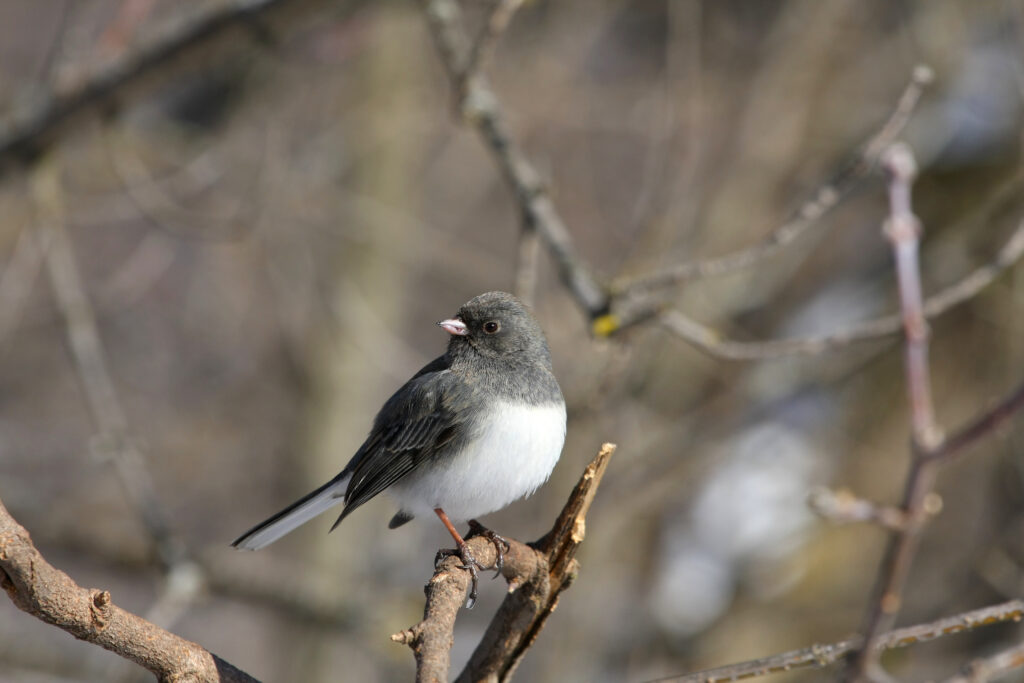
Dark-eyed Junco (Junco hyemalis) is a small, distinctive songbird native to North America.
It is known for its slate-colored plumage, conspicuous white tail feathers, and ground-feeding habits, often seen foraging under bird feeders during the winter months.
Dark-eyed Juncos display some regional variation in coloration, but the most common form has a dark gray head, neck, and upper body, with a white belly and white outer tail feathers.
The wings are also dark gray with white wing bars.
Females are similar but generally paler, with a more brownish-gray coloration.
Both sexes have a short, conical bill and a fairly long tail.
Dark-eyed Juncos are sparrows that come in a variety of hues depending on where they are found.
In the east, they are slate-colored, whereas, in the west, they are black, white, and brown.
Dark-eyed Juncos have a body length ranging from 5.1 to 6.3 inches (13 to 16 centimeters).
The weight of an adult Dark-eyed Junco typically varies between 0.6 to 1.1 ounces (18 to 30 grams).
Dark-eyed Juncos have a wingspan of approximately 7.1 to 9.8 inches (18 to 25 centimeters).
They are ubiquitous over the continent and may be found in open and somewhat forested regions, typically on the ground.
Some live year-round in the west and the Appalachian Mountains. Those who breed in Canada and Alaska travel south to the United States in the winter.
These birds primarily feed on seeds, particularly during the winter months, with a preference for small seeds from grasses and weeds.
They also consume insects and other invertebrates, particularly during the breeding season.
Below are the characteristics of the Dark-eyed Junco,
| Scientific Name | Junco hyemalis |
| Family Name | Passerellidae |
| Length | 5.5-6.3 inches (14-16 cm) |
| Weight | 0.6-1.1 oz (18-30 grams) |
| Wingspan | 7.1-9.8 inches (18-25 cm) |
| Habitat | Forests, woodlands, gardens, brushy areas |
| Food | Seeds, insects, small invertebrates |
21. Northern Flicker

Northern Flicker (Colaptes auratus) is a medium-sized woodpecker native to North America.
It is known for its striking plumage, distinctive call, and unique ground-feeding habits compared to other woodpeckers.
Northern Flickers have a brownish-gray body with black barring on the back and black spots on the chest and belly.
The head features a gray cap, a red crescent-shaped patch on the nape, and a black mustache stripe (in males).
The wings and tail display a bright yellow or red-orange underside, depending on the regional subspecies.
Both sexes have sturdy, slightly curved bills and long tails.
Northern Flickers have a body length ranging from 11 to 14 inches (28 to 36 centimeters).
The weight of an adult Northern Flicker typically varies between 3.9 to 5.6 ounces (110 to 160 grams).
Northern Flickers have a wingspan of approximately 17 to 21 inches (43 to 54 centimeters).
In woodlands and forest borders, they can be seen on the ground searching for ants and beetles.
Those who breed in Canada or Alaska migrate to the southern states, but they can be observed all year in the lower 48.
These birds primarily feed on insects, particularly ants, and beetles, which they capture by probing the ground with their long bill.
They also consume fruits, berries, seeds, and nuts.
Northern Flickers will flock to your garden feeders if you use suet and black oil sunflower seeds.
Below are the characteristics of the Northern Flicker,
| Scientific Name | Colaptes auratus |
| Family Name | Picidae |
| Length | 11-12.2 inches (28-31 cm) |
| Weight | 3.9-5.6 oz (110-160 grams) |
| Wingspan | 16.5-20.1 inches (42-51 cm) |
| Habitat | Forests, woodlands, parks, gardens |
| Food | Insects, fruits, seeds, berries, small invertebrates |
22. Chestnut-backed Chickadee

Chestnut-backed Chickadee (Poecile rufescens) is a small, energetic songbird native to the western coastal regions of North America.
It is known for its acrobatic feeding habits, sociable nature, and distinctive coloration.
Chestnut-backed Chickadees have a black cap and throat, a white face, and a chestnut-brown back and flanks.
Their underparts are pale gray, and their wings and tail are grayish-brown.
Both males and females have similar appearances.
They have a short, stout bill and a relatively long tail.
Chestnut-backed Chickadees have a body length ranging from 4.3 to 4.7 inches (11 to 12 centimeters).
The weight of an adult Chestnut-backed Chickadee typically varies between 0.3 to 0.4 ounces (8 to 12 grams).
Chestnut-backed Chickadees have a wingspan of approximately 7.5 to 8.3 inches (19 to 21 centimeters).
They use home feeders and live in flocks in the Pacific Coast’s wet evergreen forests.
The bulk of their diet consists of caterpillars, spiders, wasps, and aphids, with seeds, berries, and fruit accounting for the balance.
These birds primarily feed on insects and other invertebrates, such as spiders, caterpillars, and beetles.
They also consume seeds, fruits, and berries, especially during the non-breeding season.
Use black-oil sunflower seeds, peanuts, or suet cages to attract Chestnut Chickadees to your yard.
They’ll also make use of nest boxes.
Below are the characteristics of the Chestnut-backed Chickadee,
| Scientific Name | Poecile rufescens |
| Family Name | Paridae |
| Length | 4.3-5.1 inches (11-13 cm) |
| Weight | 0.32-0.49 oz (9-14 grams) |
| Wingspan | 6.3-7.9 inches (16-20 cm) |
| Habitat | Coniferous forests, mixed woodlands |
| Food | Insects, seeds, berries, small invertebrates |
23. Common Yellowthroat

Common Yellowthroat (Geothlypis trichas) is a small, colorful songbird native to North America.
It is known for its distinctive facial markings, bright yellow throat, and vibrant song often heard in wetlands and brushy areas.
Common Yellowthroats exhibit sexual dimorphism, with males and females having different appearances.
Males have a bright yellow throat and chest, with an olive-green back and wings.
The head features a black mask bordered by a thin white stripe above the eyes.
Females are more subdued in color, with a pale yellow throat and chest, and a brownish-olive back and wings, lacking the black mask.
Both sexes have short, slender bills and moderately long tails.
Common Yellowthroats have a body length ranging from 4.3 to 5.1 inches (11 to 13 centimeters).
The weight of an adult Common Yellowthroat typically varies between 0.3 to 0.4 ounces (8 to 11 grams).
Common Yellowthroats have a wingspan of approximately 5.9 to 7.5 inches (15 to 19 centimeters).
They spawn over much of North America, and in the spring and early summer, they may be found in marshy or wetland areas, as well as thick, tangled vegetation.
These birds primarily feed on insects and other invertebrates, such as spiders, flies, and beetles.
They forage actively in low vegetation and on the ground, often in wetland areas or dense brush.
Below are the characteristics of the Common Yellowthroat,
| Scientific Name | Geothlypis trichas |
| Family Name | Parulidae |
| Length | 4.3-5.1 inches (11-13 cm) |
| Weight | 0.32-0.49 oz (9-14 grams) |
| Wingspan | 5.9-7.5 inches (15-19 cm) |
| Habitat | Marshes, wetlands, brushy areas, fields |
| Food | Insects, spiders, small invertebrates |
Conclusion
In conclusion, Oregon’s diverse landscape and ecosystems provide a haven for a wide array of bird species.
From the vibrant American Goldfinch to the elegant Cedar Waxwing, these 23 common birds showcase the remarkable diversity and beauty that can be found throughout the state.
Whether you’re an experienced birder or simply someone who enjoys the presence of these fascinating creatures, Oregon offers endless opportunities for observing and appreciating the avian world.
As we continue to explore and learn about these birds, it is vital to prioritize conservation efforts and promote responsible birdwatching practices to ensure a thriving environment for generations to come.
So grab your binoculars, head out into nature, and immerse yourself in the enchanting world of Oregon’s feathered friends.
FAQ
Where are the best places to go birdwatching in Oregon?
Top birdwatching spots in Oregon include Malheur National Wildlife Refuge, Klamath Basin, Ridgefield National Wildlife Refuge, Yaquina Head Outstanding Natural Area, and Sauvie Island Wildlife Area.
When is the best time for birdwatching in Oregon?
Spring and fall are the best seasons for birdwatching in Oregon, as many species are either migrating or nesting during these times.
Are there any rare or endangered bird species in Oregon?
Yes, some rare or endangered species found in Oregon include the Spotted Owl, Marbled Murrelet, Western Snowy Plover, and Yellow-billed Cuckoo.
Can I find hummingbirds in Oregon?
Yes, Oregon is home to the Rufous Hummingbird, Anna’s Hummingbird, and Black-chinned Hummingbird.
Are there any birdwatching clubs or organizations in Oregon?
The Audubon Society of Portland, Oregon Birding Association, and East Cascades Audubon Society are popular birdwatching clubs and organizations in the state.
Last Updated on March 22, 2023 by Lily Aldrin

What a great endeavor Lily–thanks for sharing. I am new to Oregon and keeping my eyes peeled for the birds here!!